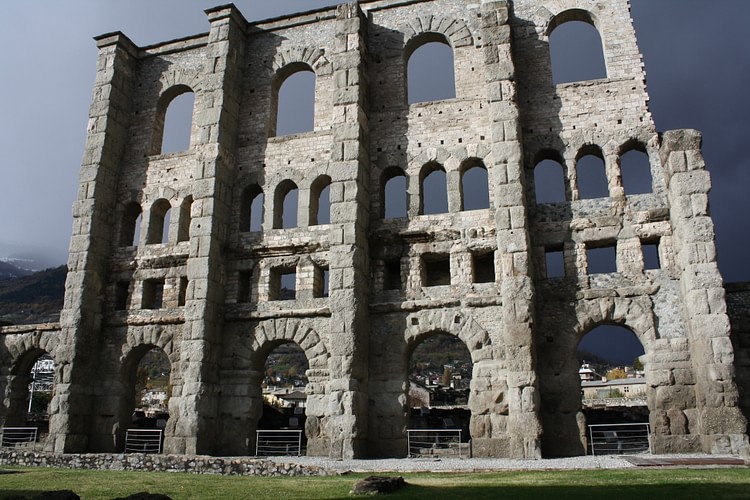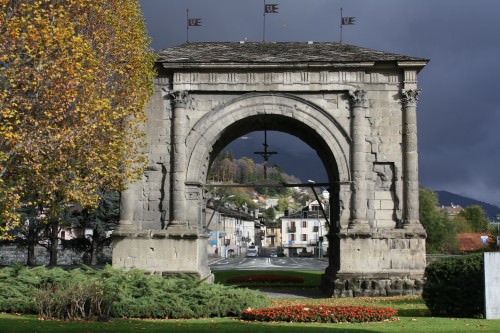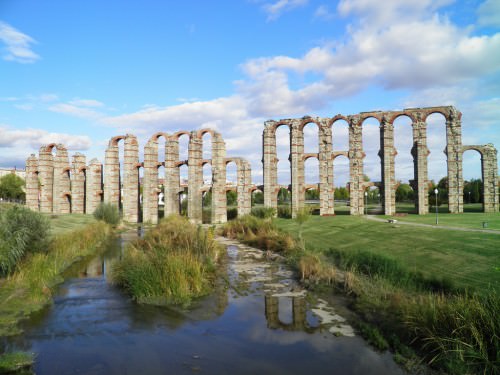Carthago Nova › Vitruvius » Ancient origins
Articles and Definitions › Contents
- Carthago Nova › Antique Origins
- Vitruvius › Who Was
Ancient civilizations › Historical and archaeological sites
Carthago Nova › Antique Origins
Definition and Origins

Along the southern coast of the Iberian Peninsula lies the ancient city of Carthago Nova (New Carthage, modern day Cartagena in Spain). Originally named Martia, the area was captured in 228 BCE by Hasdrubal Barca (brother of Hannibaland second son of Hamilicar Barca) during the Carthaginian conquest of Spain. However, it would remain under their rule for only seventeen years. In the later stages of the Second Punic War between Carthage and Rome (210-209 BCE), the Romangeneral Scipio Africanus captured the city complete with its plentiful stores and supplies, making it an imperial stronghold.The abundant natural resources: silver, lead, and iron ore, as well as its excellent harbour made it a strategic as well as a major economic acquisition.
The Roman conquest of the city brought about an unexpected advantage - Scipios's humanitarian efforts towards both prisoners as well as hostages portrayed Rome as liberators not conquerors. He would later defeat Hannibal at the Battle of Zama, ending the war and all but destroying Carthage's empire along the Mediterranean Sea.
Recent excavations of the area have shown the city to have been a very prosperous and typically Roman city with an amphitheatre, patriotic homes and even Roman walls. After a visit to the city in 133 BCE historian Polybius wrote about it in The Histories, considering it to be a true capital - spectacular temples, luxurious palaces, massive walls and a busy harbour.

Roman Theatre of Carthago Nova
The city was made a colonia by Julius Caesar in 42 BCE, and later renamed Colonia Victrix Iulia Nova Carthago by Emperor Augustus. It also played an important part in the downfall of Emperor Nero. In the Year of the Four Emperors (69 CE) Governor-general Galba of Spain was in Carthago Nova at a council of justice when he heard of the uprising in Gaul. Shortly afterwards, he was asked to “aid in rescuing humanity from Nero.” He left Spain with an army, intent on overthrowing Nero;however, Nero committed suicide before he arrived. Galba was named the new emperor, only to be assassinated a few months later at the urging of the future emperor Otho.
Later, Carthago Nova was renamed Carthaginesis and made the provincial capital of Hispania under Emperor Diocletian and, in 550 CE, despite having been conquered by the Visigoths (425 – 551 CE), Byzantine emperor Justinian made it the capital of Spania. After the Byzantines, the city came under Muslim control.
Vitruvius › Who Was
Definition and Origins

Marcus Vitruvius Pollio (c. 90 - c. 20 BCE), better known simply as Vitruvius, was a Roman military engineer and architect who wrote De Architectura ( On Architecture ), a treatise which combines the history of ancient architecture and engineering with the author's personal experience and advice on the subject. As no similar work has survived complete from antiquity, the book has become an invaluable source, not only on Greek and Roman architecture, but also on a wide range of other topics such as philosophy, mathematics, and medicine.
He served as a military engineer and architect for Julius Caesar between 58 and 51 BCE and he personally visited Greece, Asia, North Africa, and Gaul. He was considered an expert on ballistics and he also built a basilica at Fanum Fortunae (modern Fano in Umbria, Italy ) in c. 27 BCE. In De Architectura, written 30-20 BCE, Vitruvius gives a very personal account of ancient and contemporary architecture which draws on his own experience and on older works, especially by Greek writers such as Hermogenes of Alabanda, who wrote in the 2nd century BCE.
Vitruvius was a great admirer of Greek architecture in general. De Architectura was also perhaps aimed at gaining favour from the then Roman emperor Augustus (to whom it is dedicated), although it is curiously silent on many of the important buildings erected during the reign of Rome 's first emperor.
FOR VITRUVIUS BUILDINGS SHOULD ALWAYS BE THREE THINGS: BEAUTIFUL, STABLE, AND USEFUL.
DE ARCHITECTURA
Much more than a book on buildings and machines, the contents of De Architectura reveal the ancients' much wider concept of what exactly is 'architecture' and it describes such topics as science, mathematics, geometry, astronomy, astrology, medicine, meteorology, philosophy, and the importance of the effects of architecture, both aesthetic and practical, on the everyday life of citizens. In short, according to Vitruvius, the successful architect and engineer should have both theoretical and practical knowledge based on a broad and deep understanding of all the sciences, arts, and even nature. Even more importantly, for Vitruvius buildings should always be three things: beautiful, stable, and useful.
Since I notice that the uneducated rather than the educated gain favour, I have decided not to compete with the pushiness of ignoramuses, but rather to demonstrate the great value of our discipline by publishing this body of instructions.( De Architectura, Bk. 3 Introduction)
De Architectura also originally had illustrations which helped to clarify Vitruvius' descriptions, particularly those of technical devices. These are an invaluable record in themselves and his descriptions of such machines as the hodometer, which measured distances by dropping balls into a drum, intrigued such noted figures as Leonardo Da Vinci, who attempted his own reconstructive designs. Da Vinci, of course, created his famous Vitruvian Man based on the proportions described by Vitruvius (chapter 1 of Book III). Vitruvius' work is also full of anecdotes of ancient scholars and scientists, often being the only source of such now famous episodes as Archimedes in his bathtub.

Arch of Augustus, Aosta
There are some important omissions in De Architectura, notably amphitheatres, aqueduct arcades, and some of what we today might consider the greatest Roman buildings, such as Roman baths, are dealt with only briefly. Nevertheless, the work is a fascinating insight into the field of ancient architecture and it was hugely influential from the Renaissance period onwards.
Copied and re-copied right through the Middle Ages, the oldest surviving copy dates to the 8th century CE and in 1486 CE the first printed copies were published in Rome. Right up to the 20th century CE the descriptions, illustrations, and the very weight Vitruvius gave to certain topics above others influenced not only students of the subject but long-defined what was considered the primary components of western architecture
SUMMARY OF DE ARCHITECTURA
De Architectura is divided into 10 books:
Book I - on an architect's ideal education, the principles and divisions of architecture, fortifications, principles of good town planning, and where best to build a temple.
Consequently, since such a wide discipline should be enriched, and overflow with many different kinds of expertise, I do not think that people can justifiably profess themselves architects at the drop of a hat. (Bk. 1, Ch. 1.11)
Book II - on the origins of buildings and the various materials employed in their construction such as bricks, sand, stone, and wood, and the various types of walls.
Build walls two feet thick with courses of red dressed stone, fired brick or ordinary hard stone in the cavity: then the outer faces should be bound to these with iron clamps and lead. In this way the wall, which has not been built with just a pile of material but in courses, will last indefinitely. (Bk. 2, Ch. 8.4)
Book III - on the mathematics and correct proportions of columns and temples.
The upper diameters of columns should be enlarged to compensate for the increasing distances for the glance of the eye as it looks up. For our sight searches for beauty. (Bk. 3, Ch. 3.13)
Book IV - on the Doric, Ionic, and Corinthian architectural orders, and the various types of temples and altars.
If the sacred temples of the gods are to lie along public roads, they should be orientated so that passers-by can see them and make their salutations in front of them. (BK. 4, Ch. 5.2)

Floor Plan, Theatre of Marcellus
Book V - on various Roman buildings such as the basilica, the best design for theatres to obtain the best acoustics, and advice on building harbours.
The ancient architects, taking their lead from nature, designed the tiers of seats in theatres on the basis of their investigations into the rising of the voice, and tried, with the help of the mathematician's principles and musical theory, to devise ways in which any voice uttered onstage would arrive more clearly and pleasantly at the ears of the spectators. (Bk. V, Ch. 4.8)
Book VI - on the effect of climate on character and best foundations and layouts for private homes.
Bedrooms and libraries should face east since their function requires morning light, and again, so that the books in libraries will not rot. (Bk. 6, Ch. 4.1)
Book VII - on paving, vaults, and wall-paintings, including the best colours and their origins and history of use.
Purple has the most prized and most outstandingly beautiful appearance of all these colours. It is extracted from the marine shellfish from which purple dye is made, which is as amazing to the observer as anything else in nature. (Bk. 7, Ch. 8.1)
Book VIII – is concerned with water, its sources and conveyance via aqueducts.
There is a spring on the island of Cea and those who unwisely drink from it lose their minds; an epigram is inscribed there which says that a drink from the spring is delightful but that whoever drinks from it will end up with the brain of a stone. (Bk. 8, Ch. 3.22)

Los Milagros Aqueduct, Mérida
Book IX – on the study of astronomy and its relevance to architectures and the measurement of time using sundials and water-clocks.
Archimedes ecstatically jumped out of the bath without a moment's delay and rushed off home, stark naked, announcing at the top of his voice that he had found what he was looking for, since as he ran along, he shouted repeatedly in Greek 'Heureka, heureka'. (Bk. 9 Introduction)
Book X – describes various machines and gadgets such as distance measuring devices, water-driven machines, and weapons like catapults, ballistae, and siege engines.
Ropes are tightened up in the same way by means of hand-spikes and windlasses until they sound the same. In this way, by keeping the device taut with wedges, the catapults are 'tuned' to the proper pitch by musical testing.(Bk. 10, Ch. 12.2)
LICENSE:
Article based on information obtained from these sources:with permission from the Website Ancient History Encyclopedia
Content is available under License Creative Commons: Attribution-NonCommercial-ShareAlike 3.0 Unported. CC-BY-NC-SA License